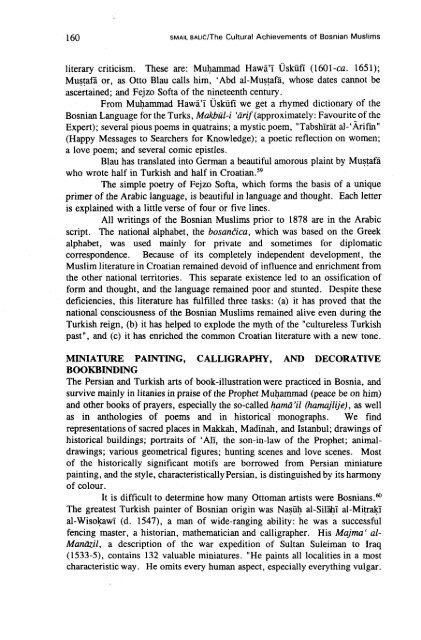Create successful ePaper yourself
Turn your PDF publications into a flip-book with our unique Google optimized e-Paper software.
160<br />
SMAIL BALICIT~~ Cultural Achievements of Bosnian Muslims<br />
literary criticism. These are: Mdpmmad Hawa'i ~skiifi (1601-ca. 165 1);<br />
Mustafa or, as Otto Blau calls him, 'Abd al-Musgfi, whose dates cannot be<br />
ascertained; and Fejzo Softa of the nineteenth century.<br />
From Mulpmmad HawB'i ~skiifi we get a rhymed dictionary of the<br />
Bosnian Language for the Turks, Makbzil-i 'drif (approximately: Favourite of the<br />
Expert); several pious poems in quatrains; a mystic poem, "Tabshirl al-'~rifm"<br />
(Happy Messages to Searchers for Knowledge); a poetic reflection on women;<br />
a love poem; and several comic epistles.<br />
Blau has translated into German a beautiful amorous plaint by Mustafa<br />
who wrote half in Turkish and half in Cr~atian.~'<br />
The simple poetry of Fejim Softa, which forms the basis of a unique<br />
primer of the Arabic language, is beautiful in language and thought. Each letter<br />
is explained with a little verse of four or five lines.<br />
All writings of the Bosnian Muslims prior to 1878 are in the Arabic<br />
script. The national alphabet, the bosantica, which was based on the Greek<br />
alphabet, was used mainly for private and sometimes for diplomatic<br />
correspondence. Because of its completely independent development, the<br />
Muslim literature in Croatian remained devoid of influence and enrichment from<br />
the other national territories. This separate existence led to an ossification of<br />
form and thought, and the language remained poor and stunted. Despite these<br />
deficiencies, this literature has fulfilled three tasks: (a) it has proved that the<br />
national consciousness of the Bosnian Muslims remained alive even during the<br />
Turkish reign, (b) it has helped to explode the myth of the "cultureless Turkish<br />
past", and (c) it has enriched the common Croatian literature with a new tone.<br />
MINIATURE PAINTING, CALLIGRAPHY, AND DECORATIVE<br />
BOOKBINDING<br />
The Persian and Turkish arts of book-illustration were practiced in Bosnia, and<br />
survive mainly in litanies in praise of the Prophet M@ammad (peace be on him)<br />
and other books of prayers, especially the so-called hami'il (hamajlije), as well<br />
as in anthologies of poems and in historical monographs. We find<br />
representations of sacred places in Makkah, Madinah, and Istanbul; drawings of<br />
historical buildings; portraits of 'Ali, the son-in-law of the Prophet; animal-<br />
drawings; various geometrical figures; hunting scenes and love scenes. Most<br />
of the historically significant motifs are borrowed from Persian miniature<br />
painting, and the style, characteristically Persian, is distinguished by its harmony<br />
of colour.<br />
It is difficult to determine how many Ottoman artists were Bosnians.@'<br />
The greatest Turkish painter of Bosnian origin was Nasiih al-Silai al-Mitr&i<br />
al-Wisobwi (d. 1547), a man of wide-ranging ability: he was a successful<br />
fencing master, a historian, mathematician and calligrapher. His Majma' al-<br />
Maniizil, a description of the war expedition of Sultan Suleiman to Iraq<br />
(1533-S), contains 132 valuable miniatures. "He paints all localities in a most<br />
characteristic way. He omits every human aspect, especially everything vulgar.
















